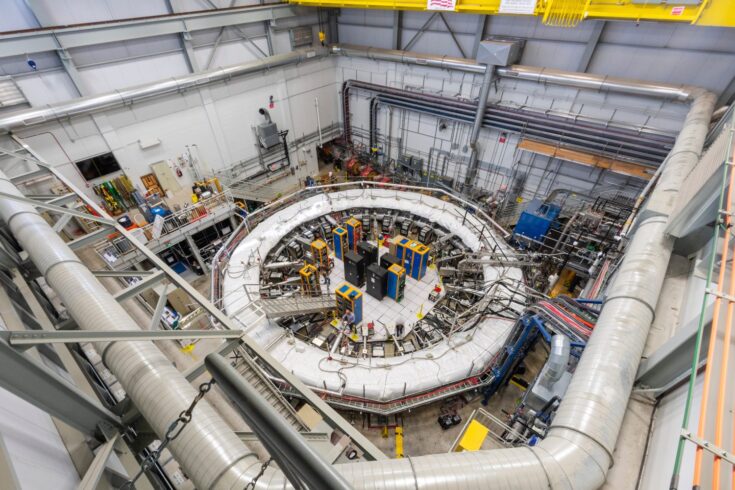UK scientists have played a key role in achieving the world’s most precise measurement of a mysterious property of the muon, a subatomic particle that could help reveal new physics beyond our current understanding.
The breakthrough was announced by the international Muon g-2 collaboration at Fermilab, the US Department of Energy’s Fermi National Accelerator Laboratory. It brings researchers one step closer to discovering forces or particles beyond the Standard Model of physics.
This result represents the most precise measurement ever made at a particle accelerator anywhere in the world, and could help unlock the secrets of the Universe.
What is the Muon g-2 experiment?
The Muon g-2 experiment investigates the subtle ‘wobble’ in the motion of muons, particles similar to electrons but with 200 times more mass, as they move through a magnetic field.
This wobble, known as the muon’s ‘anomalous magnetic moment’, or g-2, provides one of the most sensitive and precise tests of the Standard Model of particle physics, the theory that explains how fundamental particles and forces interact.
Landmark results
This announcement reveals the experiment’s third and final measurement, which confirms earlier results, but with a much better precision of 127 parts-per-billion, surpassing the original experimental design goal of 140 parts-per-billion.
These results now stand as the world’s most accurate measurement of the muon magnetic anomaly.
Representing more than a decade of work, this milestone is expected to stand as the definitive benchmark for testing the Standard Model for years to come.
Critical UK contribution
Scientists from the Universities of Lancaster, Liverpool, Manchester, and University College London were central to the experiment, which brought together 176 researchers from 34 institutions across seven countries.
The UK-built straw tracking detectors were essential in tracing the motion of the muon beam, a critical part of the analysis that enabled this unprecedented level of precision.
The power of international collaboration
Professor Sinead Farrington, Science and Technology Facilities Council Director of Particle Physics, said:
What’s really fascinating about this result is the way it has illustrated the interplay between theoretical predictions and experimental results – each can lead the other, and make demands on the precision of the other.
The UK has played critical roles of which we can be proud, both in leadership and in developing the straw tracking detectors, in this highly international collaboration.
A remarkable achievement
Professor Mark Lancaster, Principal Investigator of the UK groups, The University of Manchester, said:
This is the most precise measurement ever made at a particle accelerator and the culmination of over a decade’s work. The motion of the muon beam was exquisitely traced by the UK-built straw tracking detectors and was a key part of the analysis.
That we now have a measurement to a precision of 0.1 parts per million and a theoretical prediction, to 0.5 parts per million, is a remarkable achievement from the work of hundreds of people.
Redefining physics with precision
Lancaster University’s Dr Ian Bailey, Lecturer in accelerator physics, who leads the Lancaster University contribution to the Muon g-2 project, explained:
This beautifully precise measurement confirms that the muon can tell us something important about the nature of our Universe.
It could be another victory for the Standard Model of particle physics, or the tension between measurement and theory could resurge as the theory is understood better.
Particles don’t give up their secrets easily. We’ll need to wait a little longer to fully understand the significance of the result.
A landmark in particle physics
Professor Gavin Hesketh, based at UCL’s Department of Physics and Astronomy and the g-2 lead at UCL, said:
This result is an amazing achievement – the most precise measurement ever made with a particle accelerator! Based on previous results it looked like we had uncovered a problem in the Standard Model, which would have been a major discovery, but this sparked a huge amount of work on the theory prediction, and the latest calculation now seems to agree with our measurement.
So, perhaps not the end of the Standard Model just yet, but this measurement is still a landmark in particle physics, and as the final word from this experiment on g-2, it is a result that will not be beaten for many years to come.
The work required to reach this level of precision is mind-blowing, and a testament to everyone involved with the experiment.
Beyond expectations
Researchers at the University of Liverpool made important contributions to these latest results by:
- precisely measuring the magnetic field
- analysing the muon spin precession
- correcting for beam dynamics effects using data from detectors they designed and built
Dr Joe Price, Principal Investigator for the Muon g-2 experiment at the University of Liverpool, said:
The University of Liverpool established itself as a key institute on the experiment due to the performance of the tracking detectors, which were designed and built here.
Since then, we were able to add to the group and had people in leading roles across every aspect of the measurement.
The precision we have reached is beyond the initial expectation, and we now have a result that will be a test of New Physics for many years to come.
Find out more
Read the full press release at the Fermilab website.

